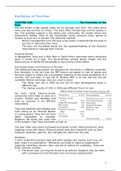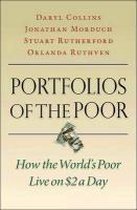Portfolios of The Poor
CHAPTER ONE The Portfolios of the
Poor
The two dollars a day people make are an average over time. You make some
more one day and less on others. The state offers limited help and the quality is
low. The greatest support is the family and community. No matter where the
researchers looked; most of the households rarely consume every penny of
income as soon as it is earned. Two potential markets:
- Money management is for the poor a key factor in determining the level of
success in improving their lives.
- The poor are frustrated about the low quality/reliability of the financial
instruments to manage their income.
Financial Diaries
In Bangladesh, India and a little later in South-Africa interviews were conducted
twice a month for a year. The South-African sample allows insight into the
financial lives of better-off households in low-income communities.
Purchasing Power and Finances of the Poor
The dollars-per-day-per-person are adjusted for the prices in different countries.
One limitation is the fact that the PPP factors are based on lists of goods and
services meant to reflect the consumption patterns of the entire population of a
country, rich and poor. A new set of ‘Poverty PPP’ is on the rise but not yet
available. Market exchange rates are used to avoid:
- The dollar rate set in 1993 by the UN for their development goals is
different now
- The median poverty of 10% in 1993 was different than it is now
Far from living hand-to-mouth,
consuming every taka as soon as it
arrived, Hamid and Khadeja had
built up reserves in six different
instruments.
They had liabilities and Khadeja was
even acting as an informal banker
or money-guard. They did not have
debts impossible to manage.
Negative net worth was quite rare
in the sample. Cash flows are better to look at.
The poor often also saved, borrowed and repaid in kind. Sharing kitchens, food,
repaying a loan with labour. Physical assets were also important such as land,
livestock, jewellery, gold etc. but changed very little over the year.
Portfolios
“I don’t really like having to deal with other people over money, but if you are
poor, there is no alternative”. Whenever you need to make an expenditure –
repairing, rebuilding, doctors’ fees, new set of clothes for a wedding – there are
three common courses:
1. The worst case, you may be forced to go without. Happens only too often,
with consequences that threaten lives and wreck opportunities
1
, 2. You may be able to raise money by selling assets, providing you have
assets to sell and a buyer pays a reasonable price.
3. You can use past or future income to fund today’s expenses. The decision
to save or borrow.
Small, Irregular, Unpredictable
In every household, even the very poorest held both savings and debt of some
sort. In all countries the total cash turnover through instruments was large
relative to total net income. All borrowed informally from family and friends and
many offered this to others.
Triple whammy: Income is low, irregular and unpredictable and there is a lack of
tools.
- Farmers earn their income during two or three peak harvest months,
earning nothing during troughs.
- Women’s paid work is often part-time, occasional or temporary.
- Full-time, permanently employed poor people suffer from irregular
payments.
- Grand recipient’s supper when grants arrive late.
Payment once a month is also inconvenient. Short-term cash-flow management
is vital to ensure that the family does not go hungry.
Coping with Risk and Raising Lump Sums
Long-term money management is associated with two other concerns
1. How to cope with risk. The diarists are less healthy, live in neighbourhoods
with weak security and face income volatility no matter where they are
employed.
a. In urban Bangladesh slums are being cleared out without warning
b. In South-Africa the spread of AIDS makes morality a concern for
young
2. The need to build or borrow usefully large sums of money.
There are three needs that drive much of the financial activity of the poor
households met:
1. Managing Basics: cash-flow management to transform irregular income
flows into a dependable resource to meet daily needs.
2. Coping with Risks. Dealing with the emergencies that can derail families
with little in reserve.
3. Raising lump sums: seizing opportunities and paying for big-ticket
expenses by accumulating usefully large sums of money.
The Portfolio Perspective
Borrowing is associated with the financing of current opportunities and needs,
insurance linked with protection against risk and saving with building large sums
for the future. In reality, life and the instruments do not always match.
Combining different instruments to achieve a need is likely. Two types of saving
- Managing day to day basics. Keep money in places that if freely and
frequently accessible. Security and convenience are important, reward not
that much.
- Saving for raising large sums.
Structure- in the form of curbs on the liquidity of the savings, and rules defining
the term, timing, and value of the deposits- helps self-discipline. The poor
2
, approach different kinds of lenders who offer loans that vary in value, term,
price, repayment structure, and availability.
Perplexing Prices
Some households pay fees for good ways to save. Western people interpret the
fees as interest rates and expressed on annual basis which seems as if the fee is
extremely high. Interest paid on very short-duration loans is more sensibly
understood as a fee than as annualized interest. To give themselves security, the
poor may even borrow in order to have something to save.
Reimagining Microfinance
Moving to microfinance from the narrower goal of microcredit begins with the
recognition that poor households want to save and insure as well as borrow. The
idea of microcredit has long been associated with the promotion of enterprise: to
enable people to purchase productive assets and working stock to set up in
business. The demand for microcredit extends well beyond the need for just
microenterprise credit; to cope with emergencies, acquire household assets, pay
schooling and health fees etc.
Reliability – on a Global Scale for the Poor
Microfinance represents a huge step in the process of bringing reliability to the
financial lives of poor households. The poor show that they are impatient for
better-quality services, inventive in bending such services to suit their purposes
and willing to pay for them. Borrowers appreciate that microfinance providers
are reliable. The providers are on time for meeting, do not bribe, distribute loans
in time at the price their promised. Microcredit loans are therefore prioritized for
repayment by clients. When you need money, moneylender may not have the
funds to lend and money guards not able to return your savings.
CHAPTER TWO The Daily
Grind
Households often have low returns, uncertain availability of work opportunities,
different sources, each irregular and unpredictable. When people are working
earning fluctuate with weather conditions, political strife, harassment by the
police and simple good and bad luck. Making uncertain income flows deliver a
stable home life is hard which results in skipping meals and variety in food
quality. Meeting pressing short-term needs by borrowing and saving for cash-
flow management in order to be able to manage immediate needs is a
precondition for long-term ambitions.
Tools are used because people are poor and characterized by frequent small-
scale transactions. Managing cash-flows is the primary goal as portfolios include
large flows of cash. Cash flows are therefore more important to focus on than
balance sheets.
Small Balances, Large Cash Flows
None of the poor lived hand to mouth. They have few financial assets; balances
are small relative to flows. When cash flows into the household and not directly
consumed it is pushed (deposit, lend, repay) or pulled (withdraw, borrow, accept
deposits) though financial instruments. The total of push and pull is the turnover.
The turnover flows were large relative to income (sometimes poor turn over
larger amounts than rich). Lower incomes require more rather than less active
financial management.
3






